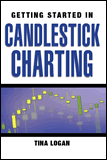$17.95 Click here to order |
Thatís where Getting Started In Candlestick Charting comes in. This book will provide you with a solid foundation from which to begin using candlestick charts. Youíll learn to recognize candlestick reversal patterns and embed them in your mind through an understanding of how they reflect the messages of crowd sentiment. Candlesticks will help you gauge the strength of price moves and spot potential reversals early, before the crowd reacts.
If you have steered clear of candlestick charting until now because it seems like there is a mind-numbing number of patterns to learn, you can put that concern to rest. It is not necessary to learn dozens of candlestick patterns. This book narrows the focus to several commonly formed candlestick reversal patterns that you can learn to recognize in short order. You can start right away utilizing candlesticks to improve your chart analysis skills, and, of course, to increase your profitability.
You will find this book very helpful if you desire to:
- Learn Candlestick Charting but don't want to get overwhelmed.
- Learn to recognize high probability trade setups.
- Improve your swing trading techniques. Candlestick charting is a stellar tool for fine-tuning swing trading strategies.
- Learn how to improve the timing of your entries and exits.
- Develop a knowledge base in classic Western technical analysis and understand the role of candlesticks within that broader framework.
